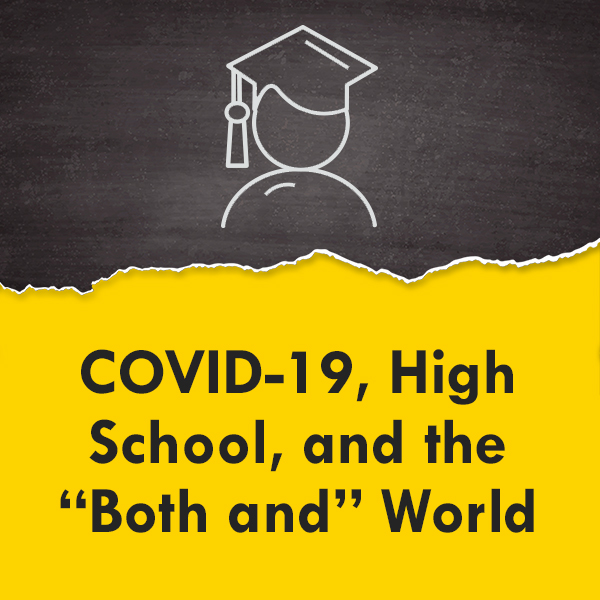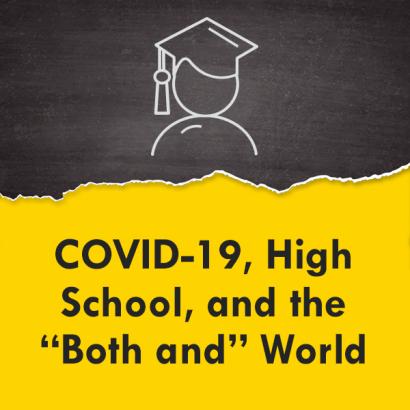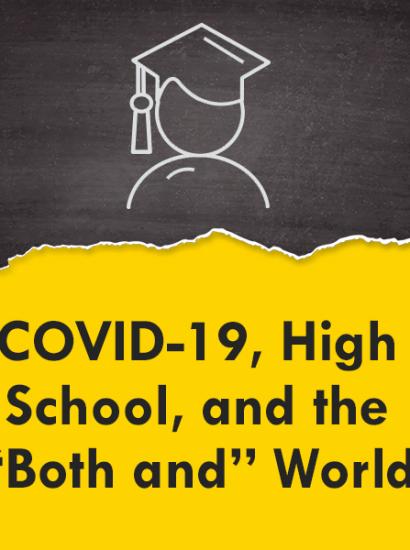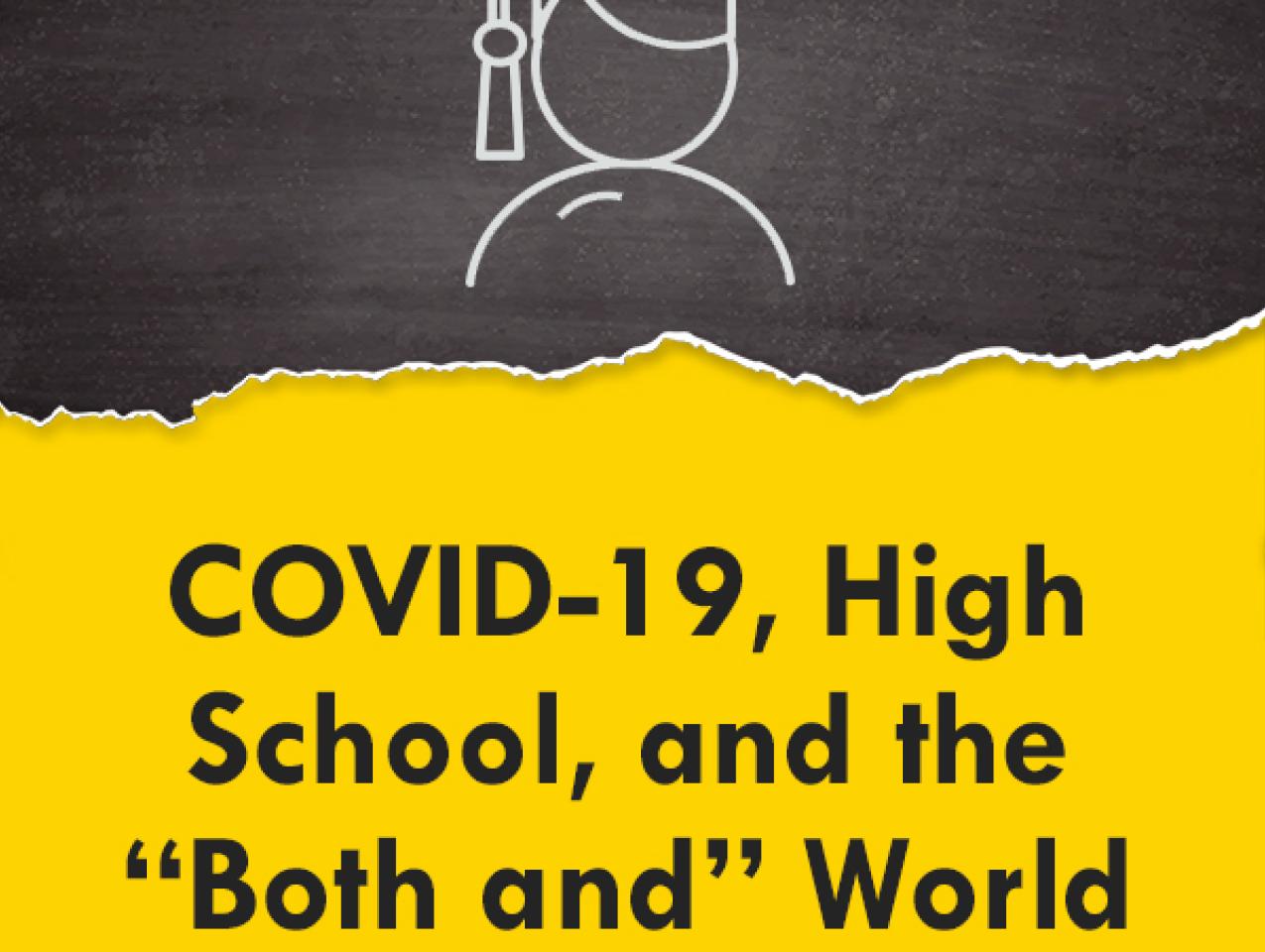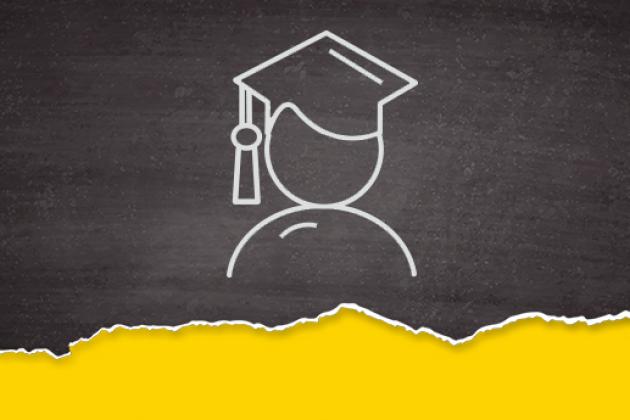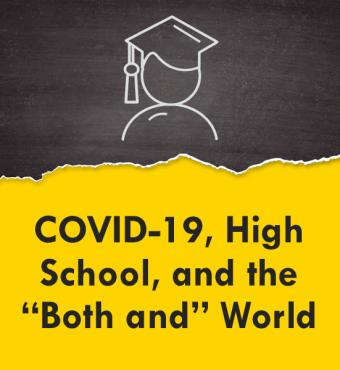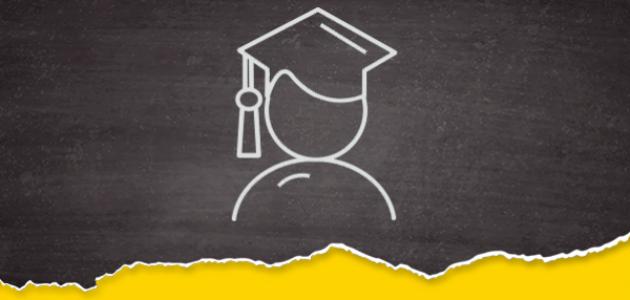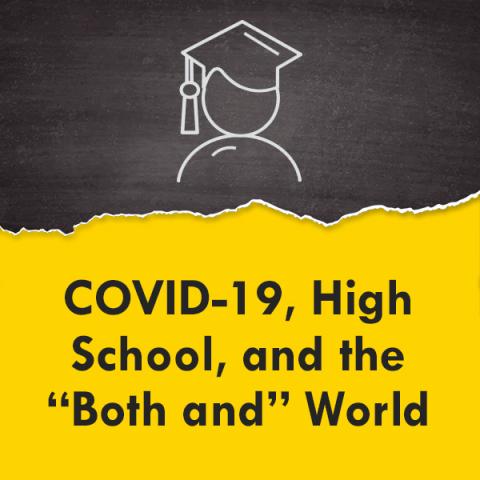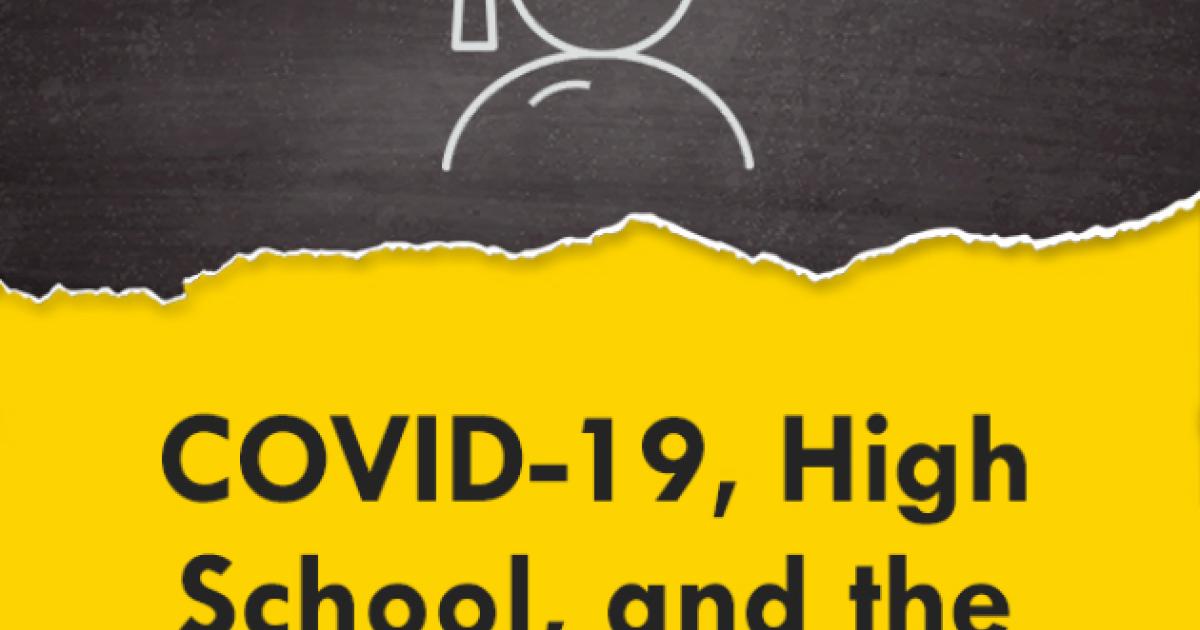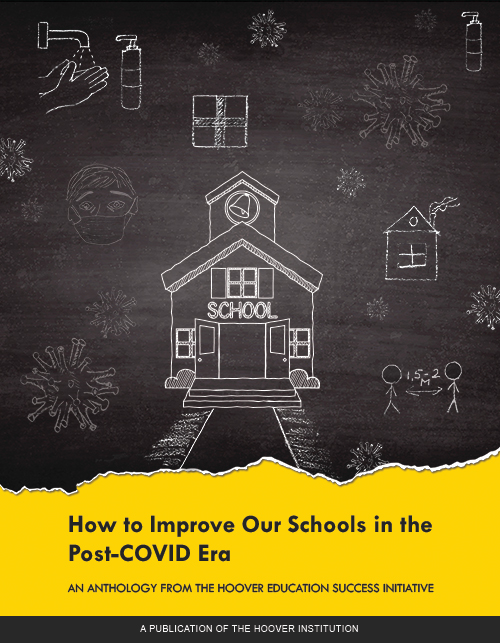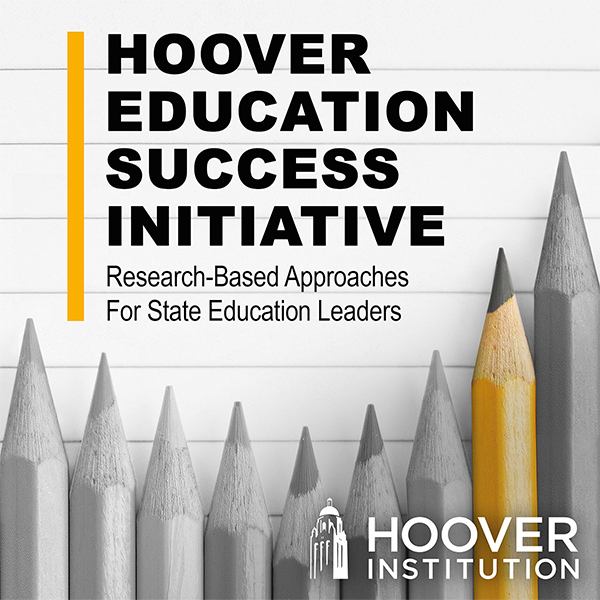- Reforming K-12 Education
Recommendations
The COVID-19 pandemic has brought into sharp focus many of the structural imperfections of American high schools: unequal educational opportunity for significant numbers of students, weak adherence to course content that would adequately prepare students for life after high school, and incoherent pathways that leave many students with a dead-end diploma. Responses to the pandemic and school closures have amplified the problem through goodwill gestures such as waiving course requirements, granting phantom credits, and more generously issuing diplomas. Instead, policy makers should embrace the disruption as a moment to introduce significant change to the way high school education is delivered in the United States, including the following:
- ✏1 Redesign high schools to be student centered and focused on knowledge and skill demonstration, including the capacity to understand the lifelong requirements for evolving skills and knowledge and to navigate the worlds of higher education, skills training, and employment to build a personal work/life plan.
- Eliminate the Carnegie Unit as the basis of school effort and replace it with solid metrics of student mastery of state learning standards. Revise the student transcript to detail what students know and are able to do.
- ✏2 Ensure that ninth graders are ready for high school work by addressing the problem of persistently low-performing elementary and middle schools.
- For the current cohorts of pandemic-impacted students, provide meaningful ancillary support so that students can offset the pandemic’s effect on their learning and prepare for future endeavors.
Where We Started
American high schools were a sore spot in the public K–12 education landscape long before COVID-19 wreaked havoc. In 2019, Hoover Education Success Initiative (HESI) scholars highlighted the sharp disparities in high school opportunities and outcomes for students across America (Raymond 2019). Differences in course offerings, course credits, course sequences, college and career readiness support, and credentialing options for living-wage employment were vast and enduring. The report found that many students are steered away from rigorous academics and encouraged to take diluted alternatives (O’Hara 2019). Students interested in securing employment after high school often find their schools’ career and technical education (CTE) offerings to be disjointed, dead-end courses (Heyward 2019). The report highlighted that far too many youths, especially those who are educationally disadvantaged, are encouraged or directed to take paths that ultimately inadequately prepare them for postsecondary life (Almond 2020).
Large differences in high school completion are a direct result; thousands of low-performing schools came into the pandemic with appallingly low graduation rates (America’s Promise Alliance 2020). Even among students who received a diploma, the credential represents a widely varying bundle of knowledge and skills. Rising graduation rates are especially troubling because of strong evidence that the gains often come from weakened criteria and not from better learning and postsecondary readiness. The evidence is strong that we have shortchanged our students for years, and the pandemic has made things even worse.
Where We Are Now
✏3 Events in 2020 and 2021 have amplified the challenges. An emerging body of evidence confirms that COVID hit low-performing schools harder than high-performing schools; those most affected have higher shares of low-income, rural, and educationally challenged students (Raymond et al. 2020; Kuhfeld et al. 2020; Dorn et al. 2020). The different impacts arise in part from varied access to the internet or to digital learning tools needed to participate in online learning. In many places, even if students have the required infrastructure and equipment, high school students found their instruction sharply curtailed. Unions have pushed hard to keep schools closed or delay reopenings (Will 2020). When schools resume, students face widespread reductions in course offerings, instructional time, and course content. The differences also stem from individual teacher choices in what and how much to teach and from how well families can support the learning experience. The short summary is that previously underserved students have incurred disproportionate harm throughout the pandemic. These findings go to the heart of renewed calls to end skewed education systems and assure equitable opportunity for all students.
The outlook for the near term remains troubling. Policy makers have focused on reopening facilities, but attending to the current and future learning impacts for students has not been as apparent. Education leaders have dwelled more openly on the psychological impacts for students despite having even less clarity on the incidence and prevalence of these effects than on the lost academic learning. They relaxed requirements to measure attendance, conduct assessments, or assign grades. Leaders in many, but not all, states have pushed to extend the suspensions through the 2020–21 school year (Diliberti and Kaufman 2020). Without further action, graduates for many years to come can expect to have diminished opportunities and lower earnings throughout their lifetimes (Hanushek and Woessmann 2020). The damage will not simply accrue to the current juniors and seniors, though they will certainly feel it more acutely than students who have more time to recover.
We are set to launch cohorts of students even less prepared than usual. Fewer students will be heading to college. Among those who do, part-time and online enrollment will provide roughly equal academic learning but will come with trade-offs in softer skill development such as teamwork and oral communication (Clinefelter, Aslanian, and Magda 2019). According to a national survey, about half of respondents reported changing their plans: deferring college (32 percent), changing career plans (16 percent), or rerouting themselves into the workforce (36 percent) (CNBC Online 2020). If and when they pursue higher education, they will arrive in an unknown state of readiness. Expecting higher-education institutions to assume the duty to assess and remediate new students is not new, but the scale of effort that will now be needed for these students is breathtaking. To date, education policy makers have not fully focused on the need to support these students beyond high school or on the needs of the postsecondary settings that will be asked to take up the slack.
Importantly, more students than ever will not be college bound. A growing proportion of high school graduates will aim first for the labor force and will quickly learn their development for the world of work has been poor. Career and technical education (CTE) options have never been strong in most high schools, but the closing of facilities disrupted many of the hands-on training experiences that did exist. Few employers continued to offer learning opportunities in the workplace. Even more than basic education course offerings, a pivot of traditional CTE such as auto mechanics to online learning reduces the chance for hands-on experience that is critical to those occupations. There is additional concern that such online career training increases the equity gap for students enrolled in career technical education courses (Blackburn 2020). Work-oriented graduates will face barriers to employment even higher than normal as millions of older workers displaced by COVID-19 are adding to their own skillsets to become attractive job candidates. Like their college-oriented peers, this group of graduates will need supplemental guidance and support, with additional education and training, before they can successfully transition to the labor force.
Where We Go from Here
In communities across the country, the pandemic has forced into sharper focus the view that our high schools do not adequately prepare our students for postsecondary opportunities. ✏4 If there is an upside to all the disruption, it is the recognition that resurrecting prior high school models will only perpetuate the earlier faults. There is a chance to create stronger academic and world-exploring experiences for all students. There is a chance to replace pervasively unequal systems that have handicapped the health, welfare, economic opportunity, and life outcomes of Black, Hispanic, and low-income students.
While the motivation is higher than ever, discussion of specific solutions has been less abundant. That is regrettable, because the prior system is already disrupted, offering fertile conditions for new directions. ✏5 A real risk is that educators and leaders who have been on the front lines of the pandemic push to revert to “before” and lose the chance for better choices. State and district leaders can pursue workable policies now that set resources and talent in directions to serve students better in the future.
1. Center the high school experience on college and career readiness for all students.
Educators and school systems regularly engage in redesign, so the prospect of change is not new. What is new is the scope and focus of change that students need. The pandemic has created the opportunity to think differently and bigger about high school pathways for all students. Typical high school tracks for college-prep or career and technical education no longer apply. Clean boundaries between college-aiming and career-interested students are a thing of the past. It is a “both and” world for high school students. Many postsecondary jobs require the same preparation as college. Most students interleave higher education and employment as they progress. Accordingly, new models of high school offer high-quality learning opportunities in which academics, career exposure, and solid credentials toward employment are integrated.
✏6 One of the most important challenges that high schools face is the need to prepare students for a world of fast-paced change in the demands for knowledge and skills. Students need a foundation of “navigation” skills to customize their own job and career plans—perhaps intentionally moving between work and college—so that they can map personalized pathways through coursework, skills training, and work experience during and after high school. High schools are best positioned to support individual plans for courses, workplace experience, and future postsecondary learning and can cultivate lifelong adaptability in the face of change.
Luckily, there are promising examples on which to build. Many high school redesign efforts have produced important learnings and success. For example, the seven school districts that engaged with the Strategy Lab have each chosen a facet of their school model as the starting place for their larger plans for school redesign. The LearnLaunch Institute is another example of a redesign hub; their Building Blocks tools supported rapid pivots to remote instruction. The XQ Institute has resources to help communities undertake meaningful, evidence-driven high school design, using design principles that aim to ensure that every student moves on to success in postsecondary life. Vibrant, high-quality instructional materials can promote active student engagement, as can dropping the boundaries between schools and their communities. Coupling academic learning and exposure to people working on real-world problems can deepen student thinking and open possibilities for further learning. Even when teachers themselves do not have the tools or time to build rich materials on their own, organizations like Nepris offer curated collections of speakers, videos, and lesson plans for classroom use. Others, like Composer, specialize in providing globally connected civics education learning and action experiences.
Given the impact of COVID-19 on the opportunity horizons for high school students, schools need short-run interventions and longer-run plans to expand foundational academics and build the base of knowledge and skills that can lead to sustainable-wage employment (The Union 2021). ✏7 Classic CTE provides few options (cosmetology, auto body repair, etc.) and produces more graduates than the local economy can support; these can be replaced with more expansive and effective online options. In-demand roles in fields such as IT or health care delivery are on the rise, if recent graduates can target them (US Bureau of Labor Statistics 2021). To do so, however, students will need a mix of guidance, high-quality training, and coursework that reliably integrates with employers’ needs. One example of emerging solutions is the Arena, which promotes an innovative model of three-way partnerships between schools, online training providers, and employers. Partnerships for roles such as certified nursing assistant, patient care technician, or IT customer support show the feasibility of winning collaborations. Each partner brings its unique expertise but shares a commitment to coordinating and calibrating skill training, applied learning, and feedback about work performance to match job-ready candidates with job opportunities. The beauty of this type of approach is the flexibility to draw on a wide range of online providers to build partnerships and change them as conditions or employment needs shift. Students find better-supported postsecondary pathways to economic stability, schools see that they can more substantively prepare students for careers, and training providers and employers see that they can benefit from sourcing and recruiting via school partnerships.
2. Leverage the disruption of classroom-based education to overhaul the Carnegie Unit metric of instruction.
✏8 The standard definition of a Carnegie Unit is 120 hours (or 7,200 minutes) of interaction between high school teachers and students over the course of a year. That is one hour per day, five days a week, for twenty-four weeks. Because it is a measure of “seat time,” it is silent on the degree of learning that occurs. It has always been a poor tool for awarding course credits toward graduation.
✏9 Now, with the wide variation in student preparedness and different approaches to teaching, the shortcomings of the Carnegie Unit make it even less suited to the reality on the ground. Instead, we should support students’ learning until they demonstrate mastery of the state learning standards in each subject and link graduation credits to those outcomes. ✏10 This will require educators to modify instruction plans according to their students’ needs. State and district leadership is vital to assuring that students and their actual learning are at the center of the K–12 system.
3. Get serious about providing all students high-quality seats in elementary and middle schools.
✏11 High school is the place where all the prior shortfalls of K–8 education success come due, and students are the ones who pay the price. High schools with low graduation rates and poor postsecondary success rates for graduates share responsibility for those results with the lower schools that did not ensure grade-level capabilities in the students they taught. The recommendations for post-COVID restructuring of high school pathways will have greater impact if students arrive in ninth grade prepared for high school work. If state and district policy makers acted solely on this recommendation, it would have transformative impact, especially in educational equality terms.
4. Build tangible ancillary funding for students from the classes of 2020 through 2024 to address their learning deficiencies.
✏12 Any student enrolled in a public high school from 2020 through 2024 will have adverse impacts from the pandemic that require immediate action. For this special case, special funds are needed for supplemental learning for recent COVID-affected graduates. Where adopted, education savings accounts (ESAs) are an option that would allow students to purchase additional education services to address their individual academic needs. State education agencies could provide accessible information about the services that ESAs or special funds could support and require any service provider wishing referrals to maintain direct links to consumer feedback. Funding could involve a mix of relief funds, tax credits, and private donations. State leaders can offer this scheme as part of the overall education recovery plan. ✏13
Conclusion
The greatest threat to high school students across the country is the real risk that we retreat to earlier, impaired policies and practices. Younger students have added this season of lost schooling to prior years of unequal schooling. ✏14 State policy leaders have a limited window to act. They should move away from a time-based approach to a mastery basis of learning, which is especially apropos since returning students will have had widely different learning during the period of remote instruction. They can open the door to novel ways to bring rich content and personal meaning together for students. They have a natural coalition of support: after so much disruption, interest in learning is high among students and families. Similarly, building better basic education and career and technical training partnerships now could build the proof needed to make significant contributions in more normalized conditions. ✏15 Replacing prior practices with effective new approaches that improve high school student outcomes could be an upside with long-term payoff.
References
Almond, Monica. 2020. “The Relevance, Effects, and Unintended Consequences of High Stakes Assessments.” Hoover Institution, February 10.
America’s Promise Alliance. 2020. “GradNation Calls for ‘Meeting the Moment’ Plan to Boost High School Graduation and Postsecondary Readiness During and Beyond COVID-19.” News release, October 1. https://www.americaspromise.org/press-release/gradnation-calls-meeting-moment-plan-boost-high-school-graduation-and-postsecondary.
Blackburn, Steven. 2020. “How Schools Can Improve CTE during COVID-19.” District Administration, June 3.
Clinefelter, David L., Carol B. Aslanian, and Andrew J. Magda. 2019. “Online College Students 2019: Comprehensive Data on Demands and Preferences.” Wiley.edu and EducationDynamics, June.
CNBC Online. 2020. “Half of Recent High School Grads Have Changed Their Plans Due to Coronavirus.” June 17. https://www.cnbc.com/2020/06/17/49percent-of-recent-high-school-grads-have-changed-plans-due-to-covid-19.html.
Diliberti, Melissa, and Julia Kaufman. 2020. “Will This School Year Be Another Casualty of the Pandemic? Key Findings from the American Educator Panels Fall 2020 COVID-19 Surveys.” RAND Corporation. https://www.rand.org/pubs/research_reports/RRA168-4.html.
Dorn, Emma, Bryan Hancock, Jimmy Sarakatsannis, and Ellen Viruleg. 2020. “COVID-19 and Learning Loss—Disparities Grow and Students Need Help.” McKinsey & Company, December 8.
Hanushek, Eric, and Ludger Woessmann. 2020. “The Economic Impacts of Learning Losses.” OECD Education Working Papers 225, September 10. https://doi.org/10.1787/21908d74-en.
Heyward, Georgia. 2019. “Career Readiness: Four Ways State Policymakers Can Transform the High School Experience for Students.” Hoover Institution, February 10.
Kuhfeld, Megan, James Soland, Beth Tarasawa, Angela Johnson, Erik Ruzek, and Jing Liu. 2020. “Projecting the Potential Impact of COVID-19 School Closures on Academic Achievement.” Educational Researcher 49, no. 8 (November 2020): 549–65.
O’Hara, Marie. 2019. “Ready or Not? Preparing Students for a Meaningful Post–High School Experience.” Hoover Institution, February 10.
Raymond, Margaret. 2019. “The Diploma Dilemma.” Hoover Institution, February 11.
Raymond, Margaret E., Chunping Han, Sofoklis Goulas, Won Fy Lee, and Charla Waeiss. 2020. “Estimates of Learning Loss in the 2019–2020 School Year.” Center for Research on Education Outcomes (CREDO), Stanford University, October. https://doi.org/10.13140/RG.2.2.26746.72642.
US Bureau of Labor Statistics. 2021. “The Occupational Outlook Handbook.” https://www.bls.gov/ooh.
The Union. 2021. “Bitney Prep Offers Small Business Startup Course to Students.” February 17, https://www.theunion.com/news/business/bitney-prep-offers-small-business-startup-course-to-students/?fbclid=iwar2jzeilxrt0x-2bfgahsyzwnitasmjkyz_gm5xnho1t1exyksbfmvs6bvg.
Will, Madeline. 2020. “How Teachers’ Unions are Influencing Decisions on School Reopenings.” Education Week, December 2.







